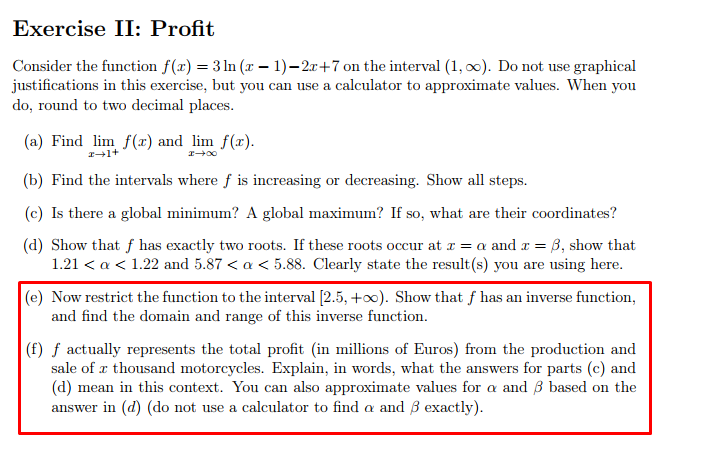(e) Now restrict the function to the interval [2.5, +). Show that ƒ has an inverse function, and find the domain and range of this inverse function.
(e) Now restrict the function to the interval [2.5, +). Show that ƒ has an inverse function, and find the domain and range of this inverse function.
Functions and Change: A Modeling Approach to College Algebra (MindTap Course List)
6th Edition
ISBN:9781337111348
Author:Bruce Crauder, Benny Evans, Alan Noell
Publisher:Bruce Crauder, Benny Evans, Alan Noell
Chapter2: Graphical And Tabular Analysis
Section2.FR1: A Further Look: Limits
Problem 1E
Related questions
Concept explainers
Equations and Inequations
Equations and inequalities describe the relationship between two mathematical expressions.
Linear Functions
A linear function can just be a constant, or it can be the constant multiplied with the variable like x or y. If the variables are of the form, x2, x1/2 or y2 it is not linear. The exponent over the variables should always be 1.
Question
Please solve parts e and f.

Transcribed Image Text:Exercise II: Profit
Consider the function f(x) = 3 ln (x –- 1)–2r+7 on the interval (1, o0). Do not use graphical
justifications in this exercise, but you can use a calculator to approximate values. When you
do, round to two decimal places.
(a) Find lim f(x) and lim f(x).
(b) Find the intervals where f is increasing or decreasing. Show all steps.
(c) Is there a global minimum? A global maximum? If so, what are their coordinates?
(d) Show that f has exactly two roots. If these roots occur at r = a and r = B, show that
1.21 < a < 1.22 and 5.87 < a < 5.88. Clearly state the result(s) you are using here.
(e) Now restrict the function to the interval [2.5, +0). Show that f has an inverse function,
and find the domain and range of this inverse function.
(f) ƒ actually represents the total profit (in millions of Euros) from the production and
sale of x thousand motorcycles. Explain, in words, what the answers for parts (c) and
(d) mean in this context. You can also approximate values for a and 3 based on the
answer in (d) (do not use a calculator to find a and B exactly).
Expert Solution
This question has been solved!
Explore an expertly crafted, step-by-step solution for a thorough understanding of key concepts.
This is a popular solution!
Trending now
This is a popular solution!
Step by step
Solved in 3 steps

Knowledge Booster
Learn more about
Need a deep-dive on the concept behind this application? Look no further. Learn more about this topic, advanced-math and related others by exploring similar questions and additional content below.Recommended textbooks for you

Functions and Change: A Modeling Approach to Coll…
Algebra
ISBN:
9781337111348
Author:
Bruce Crauder, Benny Evans, Alan Noell
Publisher:
Cengage Learning

Algebra & Trigonometry with Analytic Geometry
Algebra
ISBN:
9781133382119
Author:
Swokowski
Publisher:
Cengage

Functions and Change: A Modeling Approach to Coll…
Algebra
ISBN:
9781337111348
Author:
Bruce Crauder, Benny Evans, Alan Noell
Publisher:
Cengage Learning

Algebra & Trigonometry with Analytic Geometry
Algebra
ISBN:
9781133382119
Author:
Swokowski
Publisher:
Cengage